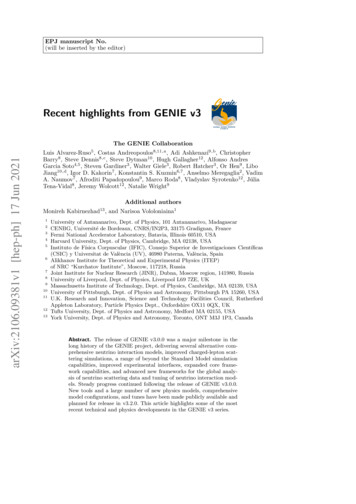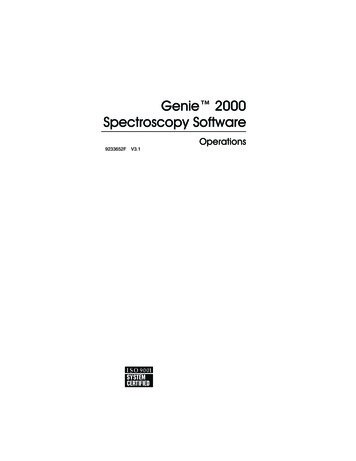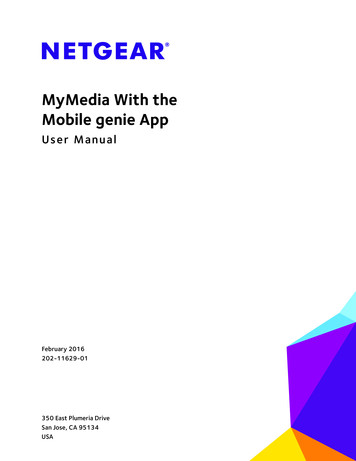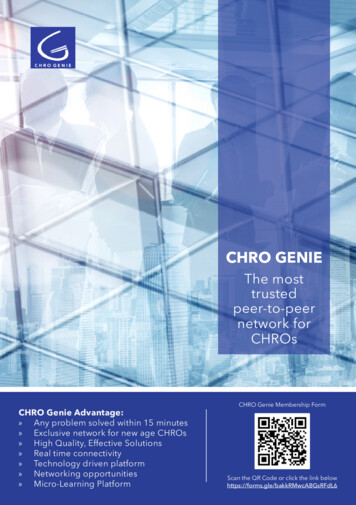
Transcription
EPJ manuscript No.(will be inserted by the editor)Recent highlights from GENIE v3The GENIE CollaborationarXiv:2106.09381v1 [hep-ph] 17 Jun 20215Luis Alvarez-Ruso , Costas Andreopoulos8,11,a , Adi Ashkenazi9,b , ChristopherBarry8 , Steve Dennis8,c , Steve Dytman10 , Hugh Gallagher12 , Alfonso AndresGarcia Soto4,5 , Steven Gardiner3 , Walter Giele3 , Robert Hatcher3 , Or Hen9 , LiboJiang10,d , Igor D. Kakorin7 , Konstantin S. Kuzmin6,7 , Anselmo Meregaglia2 , VadimA. Naumov7 , Afroditi Papadopoulou9 , Marco Roda8 , Vladyslav Syrotenko12 , JúliaTena-Vidal8 , Jeremy Wolcott12 , Natalie Wright9Additional authorsMonireh Kabirnezhad13 , and Narisoa Vololoniaina112345678910111213University of Antananarivo, Dept. of Physics, 101 Antananarivo, MadagascarCENBG, Université de Bordeaux, CNRS/IN2P3, 33175 Gradignan, FranceFermi National Accelerator Laboratory, Batavia, Illinois 60510, USAHarvard University, Dept. of Physics, Cambridge, MA 02138, USAInstituto de Fı́sica Corpuscular (IFIC), Consejo Superior de Investigaciones Cientı́ficas(CSIC) y Universitat de València (UV), 46980 Paterna, València, SpainAlikhanov Institute for Theoretical and Experimental Physics (ITEP)of NRC “Kurchatov Institute”, Moscow, 117218, RussiaJoint Institute for Nuclear Research (JINR), Dubna, Moscow region, 141980, RussiaUniversity of Liverpool, Dept. of Physics, Liverpool L69 7ZE, UKMassachusetts Institute of Technology, Dept. of Physics, Cambridge, MA 02139, USAUniversity of Pittsburgh, Dept. of Physics and Astronomy, Pittsburgh PA 15260, USAU.K. Research and Innovation, Science and Technology Facilities Council, RutherfordAppleton Laboratory, Particle Physics Dept., Oxfordshire OX11 0QX, UKTufts University, Dept. of Physics and Astronomy, Medford MA 02155, USAYork University, Dept. of Physics and Astronomy, Toronto, ONT M3J 1P3, CanadaAbstract. The release of GENIE v3.0.0 was a major milestone in thelong history of the GENIE project, delivering several alternative comprehensive neutrino interaction models, improved charged-lepton scattering simulations, a range of beyond the Standard Model simulationcapabilities, improved experimental interfaces, expanded core framework capabilities, and advanced new frameworks for the global analysis of neutrino scattering data and tuning of neutrino interaction models. Steady progress continued following the release of GENIE v3.0.0.New tools and a large number of new physics models, comprehensivemodel configurations, and tunes have been made publicly available andplanned for release in v3.2.0. This article highlights some of the mostrecent technical and physics developments in the GENIE v3 series.
2Will be inserted by the editor1 IntroductionThe release of GENIE v3.0.0 was a major milestone in the long history of the GENIEproject. The associated technical and physics modelling developments underlined thedual role of GENIE in: a) maintaining the single universal platform for delivering wellvalidated and state-of-the-art physics simulations directly into the established MonteCarlo (MC) simulation chains of nearly all neutrino experiments, and b) taking theleading role in the development, validation, characterisation and tuning of comprehensive neutrino simulations, that incorporate descriptions for all relevant processesacross the full kinematic space accessible by different types of neutrino experiments.Addressing the community demand for alternative models, GENIE v3.0.0 amalgamated large collections of modelling elements, many of which were developed withstrong community support, into a number of distinct and relatively consistent comprehensive model configurations that were validated, characterised, tuned and deployedas a whole [1]. They were the seeds around which many modelling developmentshave coalesced, leading to more well-motivated variants and tunes. The maturationof the collaborative GENIE development paradigm, along with the substantial effortinvested in curating extensive data archives of neutrino, electron and hadron scattering data, developing advanced frameworks for data/MC comparisons, tuning, andcontinuous integration underpinned a marked improvement both in the volume ofdeployed simulations and in release frequency.Steady progress continued following the release of GENIE v3.0.0, with a largenumber of new modelling elements, comprehensive model configurations and tunesplanned for release in v3.2.0. A comprehensive description of GENIE v3 is muchbeyond the scope of this article, which will only highlight some of the most recenttechnical and physics developments, with particular emphasis on new developmentsthat followed the release of v3.0.01 .This article is organised as follows: technical developments, with particular emphasis on the core generator framework improvements, a new event library interface thatallows experiments to re-use the mature GENIE experimental interfaces with thirdparty neutrino generators, and the GENIE global analysis of neutrino scattering dataare discussed in Sec. 2. New developments in the description of neutrino, electronand hadron-nucleus scattering, which are discussed in Sec. 3, are a focal point of thisarticle. Special emphasis is given in the expanded modelling of the nuclear groundstate, the careful validation and improvement of electron-nucleus scattering simulations, new models of zero-pion production (i.e. quasielastic (QE) and multi-nucleonmechanisms such as meson exchange current (MEC) or two-particle-two-hole (2p2h)excitations in general), single-pion production (including both resonant (RES) andnon-resonant (NONRES) contributions to the amplitude), new models for coherent(COH) single-photon production and coherent elastic scattering, and new advancedmodels of final state interactions (FSI) delivered through interfaces to the INCL2 [2]and Geant4 [3] codes, a complete new set of high-energy simulation modules including a next-to-leading order (NLO) deep-inelastic scattering (DIS) simulation, and ahigh-level description of all recent comprehensive configurations and tunes. Finally,in Sec. 4, we highlight recent developments in GENIE beyond the Standard Modelae-mail: publications@genie-mc.orgNow at Tel Aviv UniversitycNow at University of CambridgedNow at Virginia Polytechnic Institute and State University1A complete description of GENIE v3 will appear in future publications or in the manualavailable on the GENIE website http://www.genie-mc.org/2Liège Intranuclear Cascadeb
Will be inserted by the editor3(BSM) modelling capabilities, which form an important component of the overall program of work in GENIE, in support of the full science program of modern neutrinoexperiments.2 Technical updatesOne of the most visible updates is the evolution of GENIE into a suite of separateproducts, maintained in different repositories. Notable GENIE open-source productsinclude the: a) Generator, containing all GENIE physics modules, experimental interfaces (flux and detector geometry drivers) and a host of generic and specialised eventgeneration applications, b) Reweight, containing procedures for propagating generator uncertainties, c) Lamp, which includes a collection of scripts for building GENIEand necessary external packages, d) UnitTests, and e) AVS-CI, containing GENIE’sAutomated Validation Suite for Continuous Integration. Codes for data/MC comparisons that in earlier GENIE v2 revisions existed within the generator, were extractedand formed the basis of additional products that were the focus of substantial development from the core GENIE team over the past few years. They include the:a) Comparisons, containing curated archives of neutrino, charged-lepton and hadronscattering data, as well as highly-developed software to produce a comprehensive setof data/MC comparisons, b) Prof-GENIE, implementing the GENIE interface to theProfessor tool [4], and c) Tuning, containing the procedures implementing the GENIEglobal analysis of neutrino scattering data. The latter group of products plays a central role in the development and characterization of GENIE comprehensive modelsand tunes and in the GENIE global analysis. While this analysis is in active development, these products do not have open source releases and, therefore, a detaileddescription of the numerous developments there-in is not in the scope of this briefarticle. All the repositories corresponding to the suite of GENIE products changedfrom svn [5] to git [6], and they are hosted in the GENIE organization on GitHub,https://github.com/GENIE-MC.At a more detailed level, some of the most visible technical updates were implemented with the goal of supporting an expanded physics content and they rangefrom framework improvements to an interface for a systematic tuning procedure.Some highlights are listed below.2.1 Core software framework improvementsFrom the user point of view, the changes in the framework are all related to configuration and mostly geared toward internal consistency. As the different code modules arelargely independent, it was possible to configure physics parameters to be differentfor each model leading to the generation of events obtained with inconsistent physicssettings. For example different models could use different values of the coupling constants. To solve this issue, the concept of common parameter was introduced: theyare parameters sets that are configurable by the user and yet uniquely defined inmemory allocations accessible from every algorithm.As it was for version 2, the event generation is subdivided in different processes.In this context, processes are labelled after different scattering types (QE, RES, DIS,etc) but they are GENIE terminology to identify different event generation algorithmsthat are tailored for specific final states. In general, processes are not universal andtheir definitions are only valid within the GENIE software. This modular structurehas a large degree of configuration: for each process, the system offers a number ofalternative models to be used for event generation, see Sec. 3. In previous GENIE
4Will be inserted by the editorreleases, only one model-process mapping was suggested by the out-of-the-box configuration, despite the availability of alternative models. Yet, there was no guidanceon how to correctly use different configurations according to author and developers.Hence, it was easy to come up with inconsistencies between the model configuration for different processes that were supposed to be used together to get a correctcomprehensive physics simulation. An example of inconsistent configuration is usingthe Valencia model (see Sec. 3.3) with a relativistic Fermi gas nuclear model. Thisissue was addressed in GENIE v3 by introducing the concept of comprehensive modelconfiguration (CMC) that is a consistent process-model association. Considering thatGENIE already has about 20 different processes for neutrinos alone, CMC definitions are quite complex objects and they need to be effectively named so that thecommunity can use them unambiguously. For this purpose, the collaboration developed a specific naming convention that is described in the manual. Section 3.9 willsummarise the names and the physics relevant for for this paper. These CMCs areaimed at specific types of experiment and can be expanded according the needs ofcollaborations.A final element to be mentioned is related to the internal PDG [7] library. ThePDG values used so far in GENIE have not been changed to keep the predictionsconsistent with past versions. Now users will have the possibility to use differentPDG library configurations that are tune dependent.2.2 The new GENIE tuning processTuning is a necessary step for all MC generators. In the specific case of neutrinogenerators, it is required to merge together different models in order to avoid doublecounting, since there is no single model able to cover all possible interactions acrossthe whole energy range. Indeed, development of a global analysis of scattering datafor the tuning and uncertainty characterization of comprehensive neutrino interactionmodels has been a central activity of the core GENIE team over the past few years.The GENIE Generator is the main outlet for the GENIE global analysis results,and our goal is that, for each supported comprehensive model, several selected tunedversions shall be made available.The GENIE global analysis was made possible through the continued developmentof curated data archives, and their successful interface to the Professor tool [4]. Thisinterface enabled the efficient implementation of complex multi-parameter brute-forcescans and removed substantial global analysis limitations by decoupling it from eventreweighting procedures that, for all but the most trivial aspects of our physics domain, require substantial development time and are not exact, or even possible atall. Specifically, Professor ‘reduces the exponentially expensive process of brute-forcetuning to a scaling closer to a power law in the number of parameters, while allowingfor massive parallelisation’ [8].This concept goes beyond the existing reweighting scheme since it allows thetuning of parameters that are not normally reweightable. We expect to be able todevelop a reweighting tool based on this method for GENIE v4. After a specificexperimental flux is defined as an input, the phase space of each interaction canbe decomposed in bins seen as an observable. Eventually we expect the users andexperiments to build their own response functions to allow the reweighting of theirpredictions according to the statistical output of the tunes based on this technology.
Will be inserted by the editor52.3 Event libraryThe neutrino flux and geometry interfaces and the wealth of mature and well-testeddrivers implementing these interfaces constitute one of the most well-known and desirable GENIE features that has catalysed GENIE adoption and enabled seamlessintegration in the full MC simulation chain of all current and near-future neutrinoexperiments. No other physics generator provides an equivalent and equally comprehensive and mature toolkit and experimental interfaces. There is a strong communitydesire to reuse the GENIE experimental interfaces to test alternative physics generators. This drove the implementation of an “Event Library” interface [9] and thedevelopment of a generic EvtLib GENIE generator.The purpose of the EvtLib generator is to read from an external library of crosssections and pre-computed final particle kinematics (most likely computed using analternative neutrino generator). For each interacted neutrino selected by GENIE,the generator will use the appropriate cross section from the file, and then use thekinematics from the library entry with the closest-matching energy. Within the limitsof the library statistics, this will then reproduce the physics of the external generator,but making use of the flux and geometry handling of GENIE. The details of the eventlibrary file structure are described in the code and in the manual [10].3 Interaction modeling improvementsNeutrino-nucleus interactions are very important to many experiments and this remains a central area of effort within the GENIE collaboration. Charged-current neutrino interactions without final-state mesons (CC0π interactions) will dominate theexpected signal in future precision oscillation measurements by the Short-BaselineNeutrino program [11] and Hyper-Kamiokande [12]. Significant GENIE developmenteffort has recently been devoted to the implementation of new models of quasielasticand 2p2h interactions (see Sec. 3.3). Many channels will be important for the upcoming Deep Underground Neutrino Experiment (DUNE) [13], especially because thehigher average beam energy will enhance the role of more inelastic event topologies.Resonance production and FSI will be very important for DUNE. Recent improvements in those areas are discussed in Secs. 3.4 and 3.6, respectively.At the same time, significant efforts have gone into new capabilities at very lowenergies (Sec. 3.8) and very high energies (Sec. 3.7). In addition, the importanceof electron scattering 3.2 to determine nuclear structure 3.1 and vector interactionsis expanding. These three directions greatly enhance the reach of GENIE into newexperiments.3.1 Nuclear ground stateAt energies relevant for accelerator neutrino experiments, a variety of nucleon-levelhard scattering processes (principal interactions), such as resonance production, mustbe considered when preparing a comprehensive lepton-nucleus interaction model foruse in an event generator. However, two aspects of such a comprehensive model willbe common to all interaction modes: a description of the nuclear ground state (thesubject of this section) and a treatment of intranuclear rescattering due to hadronicfinal-state interactions (the subject of Sec. 3.6).There are a variety of methods to model the nuclear ground state. Improving thesemodels is an ongoing process within GENIE. At present, the nuclear ground state is
6Will be inserted by the editorrepresented by a spectral function P (p, E) which describes the probability that a nucleon involved in a lepton-nucleus interaction will have an initial 3-momentum p andremoval energy E. In the historical default model used since GENIE v2, the initial nucleon momentum is sampled according to the relativistic Fermi gas (RFG) treatmentof Bodek and Ritchie [14]. This version of the RFG has non-interacting nucleons upto the Fermi momentum kF , which is determined from inclusive electron scattering.It also accounts for short-range nucleon-nucleon correlations [15] by adding a highmomentum tail above kF to the usual distribution. A fixed, isotope-specific removalenergy E is used in all cases. Pauli blocking in quasielastic interactions is implementedby requiring the final-state nucleon momentum to exceed kF . The Bodek-Ritchie RFGcontinues to be used in multiple GENIE CMCs mainly for higher energy processesand connection with past modeling.Two newer nuclear model implementations are available for all target nuclides inGENIE v3.2. The first of these is a local Fermi gas (LFG) model based on the workof the Valencia group [16] and various other publications. Under this approach, thehigh-momentum tail is neglected, and kF is a function of radius obtained by Fouriertransforming the nucleon number density ρ(r). The implementation of this modelunderpins a related treatment of quasielastic and two-particle-two-hole interactions(see Sec. 3.3), in which nuclear effects such as long-range correlations and Coulombcorrections are handled according to the same local density approximation in theValencia model.A variation of the original LFG model, called the correlated Fermi gas (CFG) [17],has also been added in GENIE v3.2. The CFG keeps the radial dependence of theLFG model while adding a high-momentum tail that lies above the local kF . Theoriginal LFG distribution is renormalized to ensure that a given fraction of initialstate nucleons is found in the tail. The current default of 20% is based on electronscattering measurements [17] and may be adjusted in future GENIE tuning efforts.Both the LFG and CFG implementations in GENIE use a fixed nucleon removalenergy which is identical to that used by the Bodek-Ritchie RFG. Fig. 1 shows the p distribution predicted by each of the three models of the nuclear ground statediscussed above, where p is the initial nucleon momentum.Probability Density0.10.08RFG0.060.04LFG0.0200CFG0.10.20.3pp [GeV/c]0.40.5Fig. 1. Initial nucleon momentum magnitude distributions according to the GENIE implementation of relativistic Fermi gas, local Fermi gas and correlated Fermi gas models.
Will be inserted by the editor73.2 Electron-nucleus scatteringSince neutrinos and electrons are both leptons, they interact with atomic nuclei insimilar ways. Electrons interact via a vector current and neutrinos interact via vectorand axial-vector currents. Electron-nucleus scattering data allow for more precisemeasurements than ν-nucleus scattering due to an interaction rate that is O(107 )times higher, thanks to the high cross section. Furthermore, the knowledge of theincoming flux is more constrained. Specifically, monochromatic beams allow for properkinematic reconstruction, reducing the systematic uncertainty. These higher qualitydata allow for powerful model constraints on the vector part of lepton-nucleus crosssections. Key nuclear effects common to electron and neutrino probes, such as thenuclear ground state and hadronic FSIs, can also be studied in detail.In recent versions of GENIE, significant improvements were made for aspects ofboth neutrino and electron cross section modeling [18]. Significant errors were corrected, including a mistake in the mathematical expression used for the QE differentialcross section, a missing Lorentz boost in the 2p2h interaction affecting both electronsand neutrinos, and incorrect electron couplings used in the RES interactions. Wherever possible, the electron treatment was updated to be significantly more similar tothe neutrino one and to use the same computer code.The GENIE collaboration is in the process of benchmarking the electron scattering predictions against existing inclusive electron scattering data for different targetnuclei, beam energies and scattering angles [18], as can be seen in Fig. 2. The physicscontent of the model configurations shown is described in Sec. 3.93 . The agreementis very good for the kinematic region dominated by QE processes due to the bugfixes and adoption of newer models. On the other hand, the simulation is well abovethe data in the resonance region. This is largely due to deficiencies in modelling ofthe fundamental scattering process rather than the treatment of nuclear effects. Inparticular, the existing GENIE tunes to measurements with hydrogen and deuteriumtargets [1] only use neutrino (as opposed to electron) data. As a partial accounting,we have added the Bosted-Christy model [19, 20] as an alternate cross section for usein user-driven reweighting.The community is also in the process of reviewing and improving the electronscattering data that will be useful for our validation purposes. For example, highstatistics datasets from the CLAS6 detector at Jefferson Laboratory were analysed[21] and new experiments (e4ν, Mainz, and LDMX) designed to support neutrinointeraction experiments will start data taking in 2021 [22–24]. Major emphasis inthese new measurements will be placed on a detailed description of the hadronic partof the final state.3.3 CC0π cross sectionsInitial efforts to isolate CCQE interactions in neutrino-nucleus scattering data provedto have significant model dependence. Hence, experimental attention is now focusedon CC0π event topologies which involve three underlying processes within GENIE.CCQE and 2p2h are the main contributors; nonetheless, pion production followed byintranuclear absorption also contributes significantly to this channel.The GENIE v2 historical default model for charged-current quasielastic scatteringwas based on the Llewellyn Smith [25] formalism: the expression for the hadronic part3Please note that the GENIE configuration referred to in Ref. [18] as GSuSAv2 orGTEST19 10b 00 000 is now labeled as GEM21 11b 00 000 in GENIE version 3.02.00. Theprevious “test” configuration was promoted to a full CMC.
1038 103Will be inserted by the editor 103 GEM21 10b 00 000 103 G18 10a 02 11ao126 C, 0.56 GeV, θ 6064422002020d2σ [µb/sr/GeV]dΩ dE 0103 0.1 0.2 0.3 0.4 010340 56Fe, 0.961 GeV, θ 37.5o 4000.20.40.600.10.20.20.30.40.40.6Ar, 2.222 GeV, θ 15.5440o1001005050000.20.40.60.8Energy Transfer [GeV]000.20.40.60.8Energy Transfer [GeV]Fig. 2. Comparison of inclusive (e, e0 ) scattering cross sections for data and for GENIE. (left)data vs GEM21 10b 00 000 and (right) data vs G18 10a 02 11a. (top) carbon at E0 0.56GeV, θe 60 and Q2QE 0.24 GeV2 , (middle) iron at E0 1 GeV, θe 37.5 andQ2QE 0.32 GeV2 , and (bottom) argon at E0 2.22 GeV, θe 15.5 and Q2QE 0.33 GeV2 .Black points show the data, solid black lines show the total GENIE prediction, colored linesshow the contribution of the different reaction mechanisms: (blue) QE, (red) MEC, (green)RES and (orange) DIS.of the cross section is taken to be the same as for a free nucleon. The correspondingcross section for scattering on a complex nucleus is then computed by correctingfor Pauli blocking and binding energy, averaging over the initial nucleon momentumdistribution (see Sec. 3.1), and then multiplying by the total number of neutrons(protons) for an incident neutrino (antineutrino).The Llewellyn Smith approach is still available in GENIE v3.2 and remains agood model for neutrino energies above roughly 2 GeV. Two additional CCQE modelswhich contain details that are important for lower energy neutrinos have now alsobeen implemented. One of these is based on the formalism of the Valencia group[16] and makes two major refinements beyond Llewellyn Smith. First, long-rangenucleon correlations are treated in a Random Phase Approximation (RPA) approach.Corrections for these are included as density-dependent modifications to the freenucleon hadronic tensor. Second, corrections for the final-state Coulomb interactionof the outgoing charged lepton are introduced using a strategy similar to the “modifiedeffective momentum approximation” proposed by Engel [26]. The radial dependenceof both of these nuclear effects is taken into account by relying on the local Fermi gasmodel described in Sec. 3.1.In the GENIE implementation of the Valencia model, a correction for bindingenergy is made by assigning an off-shell total energy to the initial struck nucleon.The QE cross section is then calculated under the de Forest prescription [27]: aneffective energy transfer is used which is reduced by the amount of energy neededto put the initial nucleon on the mass shell. Nieves et al. also recommend using aneffective energy transfer in the original Valencia model publication, but their approachis different. Rather than considering nucleon knock-out, the authors reduce the energy
Will be inserted by the editor9Fig. 3. Impact of nucleon binding energy effects on GENIE cross section predictions. LEFT:MiniBooNE double-differential CC0π cross section compared to GENIE G18 10a 02 11b predictions calculated with variations to the binding energy correction. RIGHT: Differentialcross section predictions for inclusive 560 MeV electron scattering on 12 C at θ 60 . Thesolid green histogram shows the nominal prediction using the G18 10a 02 11b CMC. Thedashed blue histogram shows the same cross section when no correction for binding energyis applied. Data points are taken from Ref. [29].transfer based on the difference in ground-state masses between the initial nucleusand a final nucleus that includes the outgoing nucleon4 .The left-hand plot in Fig. 3 shows a comparison of GENIE calculations to MiniBooNE CC0π data [28] in which both the default binding energy treatment (solidgreen) and original Valencia model approach (dotted violet) have been applied. Noticeably better agreement is achieved in the backwards-angle bins with the Valenciaprocedure. Interestingly, further overall improvement is seen if binding energy corrections are neglected entirely (dashed blue). The importance of binding energy corrections for low-energy lepton-nucleus scattering is further highlighted in the right-handplot of Fig. 3, which shows a comparison of GENIE predictions to data obtained for560 MeV electrons on 12 C at a scattering angle of θ 60 . Here the default GENIEapproach to binding energy (solid green) achieves much better agreement with themeasured QE peak location than the prediction where binding energy is neglectedentirely (dashed blue). The Q2 values represented by the data points in the right-handplot (ranging between 0.17–0.31 GeV2 ) are roughly comparable to the MiniBooNEflux-averaged mean Q2 0.4 GeV2 predicted by the GENIE G18 10a 02 11b simulation.A second new CCQE model in GENIE [30] implements the SuSAv2 treatment[31]. Under this approach, the nuclear responses are calculated using scaling functions based on Relativistic Mean Field (RMF) theory. A precomputed table of theseresponses, defined on a two-dimensional grid in energy and momentum transfer, isinterpolated for efficient sampling of final-state lepton kinematics. Handling of suchtabular input for QE and 2p2h models is an important new capability added in v3.2.A factorisation strategy is employed to simulate the outgoing nucleon: the leptonic4-momentum transfer is applied to a nucleon drawn at random from the initial-statesingle nucleon distribution (see Sec. 3.1). The limitations of this approximation areconsidered in Ref. [30].New models of 2p2h interactions have also been recently implemented in GENIEfollowing the Valencia [32, 33] and SuSAv2 [34, 35] approaches. These provide theorydriven alternatives to the Empirical model [36] available since late releases of GENIE4A correction is also made for the difference in Fermi energies between the final and initialnucleon species, see Eq. (43) in Ref. [16].
10Will be inserted by the editordσ/dW (cm / GeV / Ar)Llewellyn-Smith0.25 10 .2SuSAv2222dσ/dQ (cm / GeV / Ar) 360.3 11.201.81.422Q (GeV )1.922.12.22.32.42.52.62.7W (GeV)Fig. 4. Differential cross sections predicted by several different GENIE treatments of νµcharged-current quasielastic (left) and two-particle-two-hole (right) interactions on argon.All distributions shown are averaged over the MicroBooNE νµ flux.v2. In contrast to the QE case, the SuSAv2-MEC model is based on a relativisticFermi gas description of the nucleus. Both new 2p2h models rely on an implementationstrategy similar to the one used for SuSAv2 QE: inclusive differential cross sectionsare calculated using tables of nuclear response
isons that in earlier GENIE v2 revisions existed within the generator, were extracted and formed the basis of additional products that were the focus of substantial de-velopment from the core GENIE team over the past few years. They include the: a) Comparisons, containin










